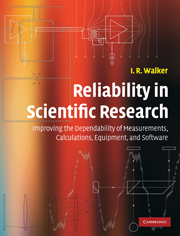 Reliability in Scientific Research
Reliability in Scientific Research Book contents
- Frontmatter
- Contents
- Preface
- List of abbreviations
- 1 Basic principles of reliability, human error, and other general issues
- 2 Mathematical calculations
- 3 Basic issues concerning hardware systems
- 4 Obtaining items from commercial sources
- 5 General points regarding the design and construction of apparatus
- 6 Vacuum-system leaks and related problems
- 7 Vacuum pumps and gauges, and other vacuum-system concerns
- 8 Mechanical devices and systems
- 9 Cryogenic systems
- 10 Visible and near-visible optics
- 11 Electronic systems
- 12 Interconnecting, wiring, and cabling for electronics
- 13 Computer hardware and software, and stored information
- 14 Experimental method
- Index
- References
4 - Obtaining items from commercial sources
Published online by Cambridge University Press: 05 June 2012
- Frontmatter
- Contents
- Preface
- List of abbreviations
- 1 Basic principles of reliability, human error, and other general issues
- 2 Mathematical calculations
- 3 Basic issues concerning hardware systems
- 4 Obtaining items from commercial sources
- 5 General points regarding the design and construction of apparatus
- 6 Vacuum-system leaks and related problems
- 7 Vacuum pumps and gauges, and other vacuum-system concerns
- 8 Mechanical devices and systems
- 9 Cryogenic systems
- 10 Visible and near-visible optics
- 11 Electronic systems
- 12 Interconnecting, wiring, and cabling for electronics
- 13 Computer hardware and software, and stored information
- 14 Experimental method
- Index
- References
Summary
Introduction
Generally, nearly all of the equipment, devices, substances, and software that are employed in scientific research are of commercial origin. It is clear from everyday experience that the reliability and usability of such products can range from superb to abysmal. (Usability has an impact on overall reliability through its effect on human error.) Low-quality items, coupled with poor documentation (e.g. operating instructions), and lack of after-sales technical support from the companies that made them, can have a very harmful effect on laboratory productivity. The purpose of this chapter is to provide ways of avoiding such problems.
Using established technology and designs
As was pointed out in a general context on page 4, if reliability is important, one should not normally employ devices or software that use a technology which has not previously been in commercial production. Most innovative things have unforeseen problems (sometimes in very significant numbers), which can be found and dealt with only after such things have been tested by many users over an extended period. This is a particularly serious issue with computer software (see page 504).
- Type
- Chapter
- Information
- Reliability in Scientific ResearchImproving the Dependability of Measurements, Calculations, Equipment, and Software, pp. 116 - 126Publisher: Cambridge University PressPrint publication year: 2011


